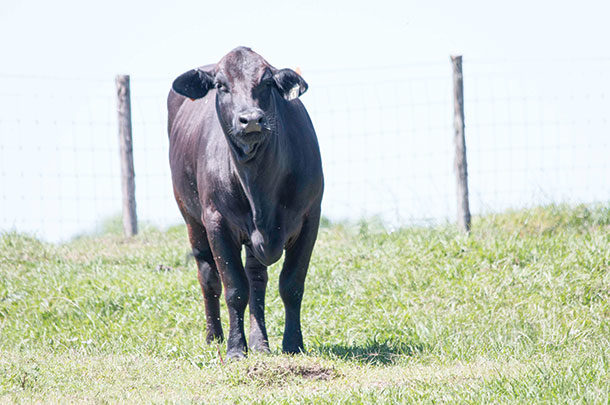But what do we actually do differently? Well, that requires a longer answer.
When it comes to heifer development, it is important to realize that Bos indicus-influenced heifers reach puberty at later ages than Bos taurus. However, with proper management, these heifers can still be bred to calve at 2 years of age – this was clearly demonstrated by researchers in the southern U.S. in the 1950s and 1960s.
There are two metrics I encourage beef producers to use routinely when evaluating the development of beef heifers: target weights and reproductive tract scores.
Most producers are familiar with the concept of a target weight, with a common recommendation being that heifers are developed to 55 to 65 percent of the weight of a mature cow by the time of breeding. Among Bos taurus, there is some debate as to whether a 55 percent versus a 65 percent target weight is most appropriate and economical.
However, research has shown Bos indicus-influenced heifers developed to lower target weights have lower rates of puberty attainment and poor pregnancy success. I encourage producers of Bos indicus-influenced heifers to use a 65 percent target weight.
Remember that target weight is the minimum weight for heifers in the group, not the average. If there is a lot of variation in the age and weight of heifers, split heifers into different management groups so that lighter weight, younger heifers can be pushed harder nutritionally. Also, be sure you are aiming at the right target: Your mature cows may not weigh what you think they do.
If you can’t obtain actual weights on cows, estimate mature cow weight based on cull cow sale weights. Since cull cows are often thin when sold, be sure to correct these weights for body condition score. One condition score is roughly 80 pounds.
Reproductive tract scoring is another metric to evaluate development of heifers. A veterinarian palpates the ovaries and uterine horns and assigns a score ranging from 1 to 5 (1=infantile; 2=prepubertal; 3=peripubertal; 4=pubertal, follicular phase; 5=pubertal, luteal phase). Because the reproductive tract is assessed directly for individual heifers, heifers can be culled or sorted into management groups based on their pubertal status.
Tract scoring should be performed four to six weeks prior to breeding; scores before that time are not very informative. A good metric is that over half of the heifers are pubertal (reproductive tract score 4 or 5) at this time. If that is not the case, reassess the nutritional development program.
Research in Bos taurus heifers has shown that reproductive tract score is predictive of pregnancy rates to fixed-time artificial insemination, pregnancy rates by day 50 of the breeding season and weaning weights of calves. In recent experiments with Bos indicus-influenced heifers, we found much of the same relationship between reproductive tract score and date of conception within the breeding season.
And remember, when it comes to heifer development, it is not just about whether a heifer becomes pregnant, but about when she becomes pregnant. Heifers conceiving early in the breeding season have much higher lifetime productivity as cows in the herd. Think about reproductive tract scoring as a tool to assess pubertal development of heifers directly rather than relying on weight alone as an indirect indicator. A bonus is that the veterinarian will also identify any heifers that have abnormal tracts (e.g., freemartins) or that are carrying a pregnancy because somebody jumped out of your bull pen (or your neighbor’s).
Breeding protocols
When it comes to estrus synchronization and timed artificial insemination protocols specifically designed for Bos indicus-influenced females, options are somewhat limited. Currently, only one protocol for Bos indicus-influenced cows is widely publicized by the Beef Reproduction Task Force: the PG 5-d CO-Synch + CIDR. This protocol is more commonly referred to as “Bee Synch” because it was developed at the Texas A&M AgriLife Research Station in Beeville, Texas. A number of producers in the southern U.S. are using this protocol in Bos indicus-influenced cow herds with encouraging results.
For Bos indicus-influenced heifers, however, there are no protocols specifically recommended by the Beef Reproduction Task Force. For Bos taurus heifers, there are four recommended: two short-term protocols (5-d CO-Synch + CIDR and 7-d CO-Synch + CIDR) and two long-term protocols (MGA-PG and 14-d CIDR-PG). Published results using these protocols in Bos indicus-influenced heifers are limited. While the short-term and long-term protocols have not been directly compared in Bos indicus-influenced heifers, results with the short-term protocols have been mixed. However, the long-term, progestin-based protocols appear to be very effective.
In one recent experiment, we reported results using the 14-d CIDR-PG protocol among Bos indicus-influenced heifers in a subtropical environment and Bos taurus heifers in a temperate environment. Although pregnancy rates to fixed-time artificial insemination were lower among Bos indicus-influenced heifers overall due to a lower average reproductive tract score, similar pregnancy rates were observed within respective reproductive tract score categories.
Similarly, in a separate experiment, we also found the MGA-PG protocol to be effective in Bos indicus-influenced heifers, with similar results to those published for Bos taurus heifers when accounting for reproductive tract score. Based on these results, it appears the long-term, progestin-based protocols function similarly in Bos indicus-influenced and Bos taurus heifers from a physiological perspective. The lower results we sometimes see in Bos indicus-influenced heifers are largely due to lower rates of cyclicity. Whether Bos taurus or Bos indicus-influenced, a large proportion of heifers need to be pubertal prior to synchronization for best results.
There is no such thing as a magic bullet when it comes to breeding Bos indicus-influenced heifers. But think of heifer development as improving your aim. Develop Bos indicus-influenced heifers to a 65 percent target weight and have the heifers reproductive tract scored. Pair that heifer development with a progestin-based estrus synchronization protocol like the 14-d CIDR-PG, and you have a great shot of setting up Bos indicus-influenced heifers for a lifetime as productive cows. ![]()
PHOTO: Bos indicus-influenced heifers reach puberty at later ages than Bos taurus. Photo by Cassidy Woolsey.

-
Jordan Thomas
- Assistant Extension Professor
- University of Missouri
- Email Jordan Thomas









